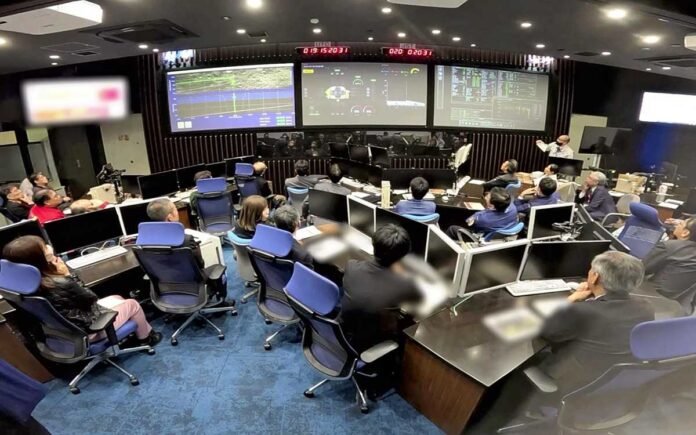Officials from the Japan Aerospace Exploration Agency and others observe the operation of the Smart Lander for Investigating Moon after it landed.
17:15 JST, January 21, 2024
A JAXA moon probe has landed, giving Japan a foothold in the global space race.
Space-related business activities involving the moon are expected to increase, so it is important to reduce the risk of conflict over resource development.
“There is fierce competition all over the world. Our probe has achieved landing, which has paved the way to the moon,” Hiroshi Yamakawa, president of the Japan Aerospace Exploration Agency (JAXA), said early Saturday morning at a press conference at the Institute of Space and Astronautical Science in Sagamihara.
Yamakawa was referring to the landing of the Smart Lander for Investigating Moon, or SLIM. The main purpose of the mission is to test so-called pinpoint landing technology, which aims to descend close to a target location on the lunar surface.
Lunar probes recently launched by the United States, Russia and India have landed from within a few kilometers to several tens of kilometers of their target locations. The goal of SLIM is to land within just 100 meters of the target.
“It’s like passing New Chitose Airport in Hokkaido at several times the speed of an airplane, then immediately slowing down and landing at Koshien Stadium [in Hyogo Prefecture],” says Shinichiro Sakai, manager of the SLIM project team.
If this technology can work reliably, it will make ‘landing true’ possible [a spacecraft] wants to land” instead of the conventional “land where it can land.”
Lunar sources
Shinichi Nakasuka, a professor at the University of Tokyo who specializes in space technology, emphasized the importance of acquiring world-class precision landing technology. “It will increase Japan’s international presence in the field of lunar exploration,” Nakasuka said.
Until now, space development has been led through multilateral cooperation by the International Space Station (ISS), with the participation of Japan, the United States, European countries and Russia, among others. However, ISS operations are expected to end in 2030, and China will begin full operation of its own space station in 2022.
The focus of space development shifts from orbit close to Earth to the more distant moon. Since 2019, the United States has been engaged in the Artemis Plan, a manned lunar exploration mission in which Japan is participating, with a plan to establish a base on the moon.
China has also announced its plan to build a moon base, and Russia has expressed willingness to cooperate.
Each country is targeting the water resources believed to be present in the moon’s polar regions. Water is essential for human activities and can also be used as fuel for spacecraft by producing hydrogen and oxygen through electrolysis.
Last August, India’s Chandrayaan-3 probe became the world’s first to land near the moon’s south pole to explore water resources. Indian Prime Minister Narendra Modi watched the live broadcast of the landing and the entire country worked together to move the project forward.
Japan’s landing technology will be advantageous in seeking lunar resources, such as water and minerals, before other countries. Japan has so far developed landing technologies adapted to different environments, such as those used by the asteroid probe Hayabusa2.
This knowledge is expected to be applied to the exploration and development of even more distant celestial bodies, such as Mars.
Risk of conflict
However, as more countries move forward with lunar exploration, the risk of conflict is likely to increase. The UN Space Treaty neither prohibits nor permits the use or possession of resources, so a first-come, first-served approach can be applied to lunar development.
A struggle or leadership has already emerged. In 2020, the United States proposed the Artemis Accords, which allow the use of space resources and advocate avoiding interference in the activities of other countries. So far, 33 countries, including Japan, have signed the agreement.
The pact is non-binding, but if a large number of countries join, it could become de facto international law. This has made China increasingly vigilant against it.
To promote the space industry, many countries are also in the process of introducing domestic laws that would allow the private sector to own space resources.
Under the Business Promotion Act for the Exploration and Development of Space Resources that came into effect in Japan in 2021, the government approves the exploration and development of space resources and basically requires the disclosure of project details. The law aims to reduce the risk of conflict by ensuring transparency and encouraging companies to enter the space sector.
The success of the SLIM landing could stimulate private sector participation.
“The disclosure of information under the law is expected to help coordinate interests with other countries and reduce the risk of disputes,” said Prof. Soichiro Kozuka of Gakushuin University, an expert in space law.



